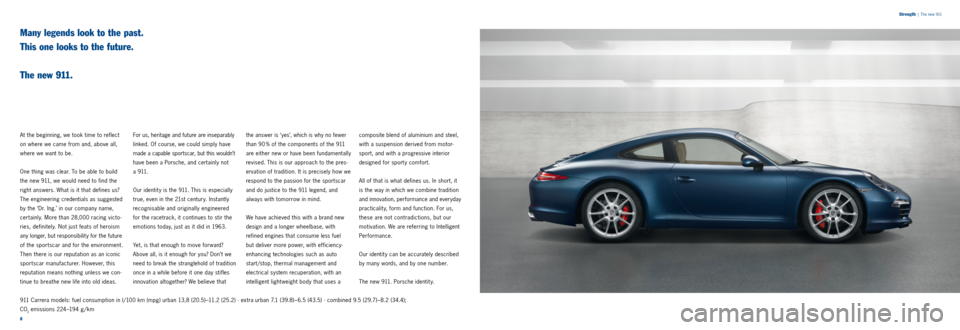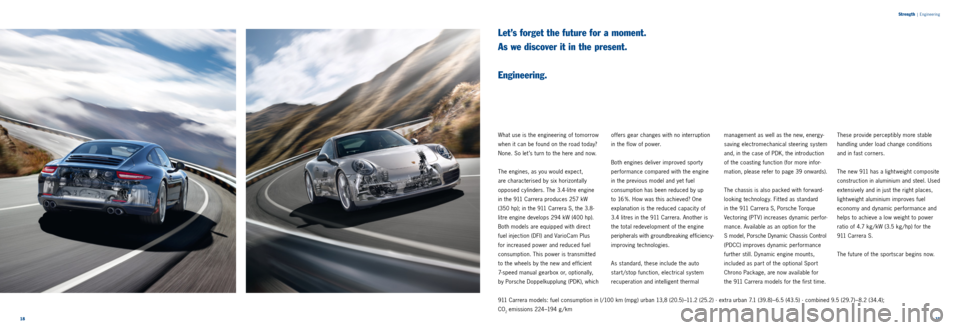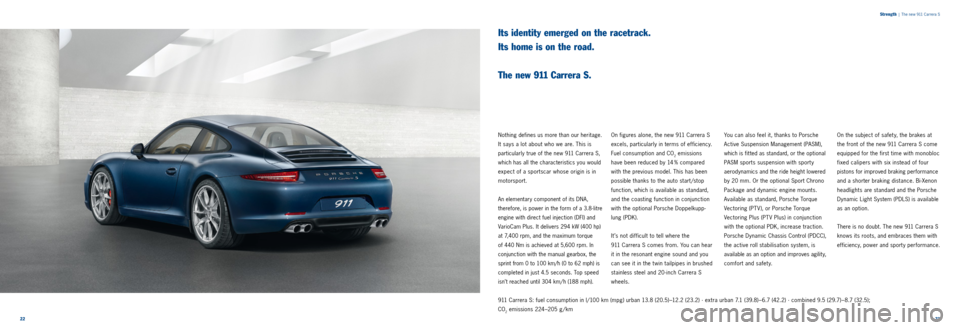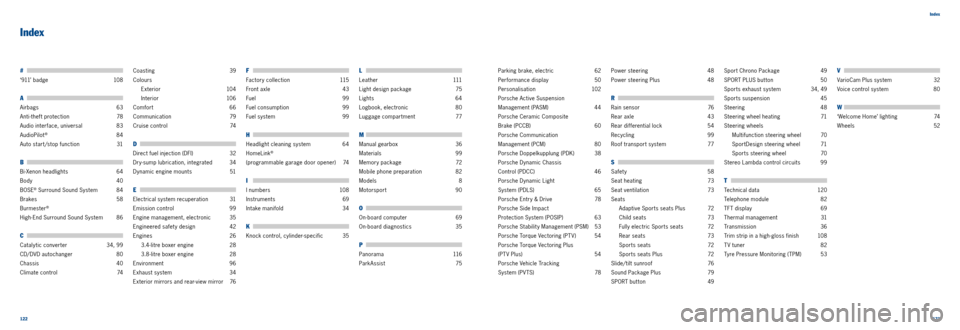stop start PORSCHE 911 CARRERA 2011 6.G Information Manual
[x] Cancel search | Manufacturer: PORSCHE, Model Year: 2011, Model line: 911 CARRERA, Model: PORSCHE 911 CARRERA 2011 6.GPages: 63, PDF Size: 9.45 MB
Page 4 of 63

9
8
Many legends look to the past.
This one looks to the future.
The new 911.
At the beginning, we took time to reflect
on where we came from and, above all,
where we want to be.
One thing was clear. To be able to build
the new 911, we would need to find the
right answers. What is it that defines us?
The engineering credentials as suggested
by the ‘Dr. Ing.’ in our company name,
certainly. More than 28,000 racing victo -
ries, definitely. Not just feats of heroism
any longer, but responsibilit y for the future
of the sportscar and for the environment.
Then there is our reputation as an iconic
sportscar manufacturer. However, this
reputation means nothing unless we con -
tinue to breathe new life into old ideas. For us, heritage and future are inseparably
linked. Of course, we could simply have
made a capable sportscar, but this wouldn’t
have been a Porsche, and certainly not
a 9 11 .
Our identit y is the 911. This is especially
true, even in the 21st century. Instantly
recognisable and originally engineered
for the racetrack, it continues to stir the
emotions today, just as it did in 1963.
Yet, is that enough to move forward?
Above all, is it enough for you? Don’t we
need to break the stranglehold of tradition
once in a while before it one day stifles
innovation altogether? We believe that
the answer is ‘yes’, which is why no fewer
than 90 % of the components of the 911
are either new or have been fundamentally
revised. This is our approach to the pres -
ervation of tradition. It is precisely how we
respond to the passion for the sportscar
and do justice to the 911 legend, and
always with tomorrow in mind.
We have achieved this with a brand new
design and a longer wheelbase, with
refined engines that consume less fuel
but deliver more power, with efficiency-
enhancing technologies such as auto
start /stop, thermal management and
electrical system recuperation, with an
intelligent light weight body that uses a composite blend of aluminium and steel,
with a suspension derived from motor
-
sport, and with a progressive interior
designed for sport y comfort.
All of that is what defines us. In short, it
is the way in which we combine tradition
and innovation, performance and everyday
practicality, form and function. For us,
these are not contradictions, but our
motivation. We are referring to Intelligent
Performance.
Our identit y can be accurately described
by many words, and by one number.
The new 911. Porsche identit y.
911 Carrera models: fuel consumption in l/100 km (mpg) urban 13,8 (20.5) –11.2 (25.2) · extra urban 7.1 (39.8) – 6.5 (43.5) · combined 9.5 (29.7) –8.2 (34.4);
CO
2 emissions 224–194 g / km
Strength | The new 911
Page 9 of 63

1819
Strength
|
Engineering
Let’s forget the future for a moment.
As we discover it in the present.
Engineering.
What use is the engineering of tomorrow
when it can be found on the road today?
None. So let ’s turn to the here and now.
The engines, as you would expect,
are characterised by six horizontally
opposed cylinders. The 3.4-litre engine
in the 911 Carrera produces 257 kW
(350 hp); in the 911 Carrera S, the 3.8-
litre engine develops 294 kW (400 hp).
Both models are equipped with direct
fuel injection (DFI) and VarioCam Plus
for increased power and reduced fuel
consumption. This power is transmit ted
to the wheels by the new and efficient
7-speed manual gearbox or, optionally,
by Porsche Doppelkupplung (PDK), which offers gear changes with no interruption
in the flow of power.
Both engines deliver improved sport y
performance compared with the engine
in the previous model and yet fuel
consumption has been reduced by up
to 16 %. How was this achieved? One
explanation is the reduced capacit y of
3.4 litres in the 911 Carrera. Another is
the total redevelopment of the engine
peripherals with groundbreaking efficiency-
improving technologies.
As standard, these include the auto
start/stop function, electrical system
recuperation and intelligent thermal management as well as the new, energy-
saving electromechanical steering system
and, in the case of PDK, the introduction
of the coasting function (for more infor
-
mation, please refer to page 39 onwards).
The chassis is also packed with forward-
looking technology. Fit ted as standard
in the 911 Carrera S, Porsche Torque
Vectoring (PT V) increases dynamic perfor -
mance. Available as an option for the
S model, Porsche Dynamic Chassis Control
(PDCC) improves dynamic performance
further still. Dynamic engine mounts,
included as part of the optional Sport
Chrono Package, are now available for
the 911 Carrera models for the first time. These provide perceptibly more stable
handling under load change conditions
and in fast corners.
The new 911 has a light weight composite
construction in aluminium and steel. Used
extensively and in just the right places,
lightweight aluminium improves fuel
economy and dynamic performance and
helps to achieve a low weight to power
ratio of 4.7 kg / kW (3.5 kg / hp) for the
9 11 C a r r e r a S .
The future of the sportscar begins now.
911 Carrera models: fuel consumption in l/100 km (mpg) urban 13,8 (20.5) –11.2 (25.2) · extra urban 7.1 (39.8) – 6.5 (43.5) · combined 9.5 (29.7) –8.2 (34.4);
CO
2 emissions 224–194 g / km
Page 11 of 63

2223
Strength
| The new 911 Carrera S
Its identity emerged on the racetrack.
Its home is on the road.
The new 911 Carrera S.
Nothing defines us more than our heritage.
It says a lot about who we are. This is
particularly true of the new 911 Carrera S,
which has all the characteristics you would
expect of a sportscar whose origin is in
motorsport.
An elementary component of its DNA,
therefore, is power in the form of a 3.8-litre
engine with direct fuel injection (DFI) and
VarioCam Plus. It delivers 294 kW (400 hp)
at 7,400 rpm, and the maximum torque
of 440 Nm is achieved at 5,600 rpm. In
conjunction with the manual gearbox, the
sprint from 0 to 100 km/h (0 to 62 mph) is
completed in just 4.5 seconds. Top speed
isn’t reached until 304 km/ h (188 mph).
On figures alone, the new 911 Carrera S
excels, particularly in terms of efficiency.
Fuel consumption and CO
2 em issio ns
have been reduced by 14 % compared
with the previous model. This has been
possible thanks to the auto start /stop
function, which is available as standard,
and the coasting function in conjunction
with the optional Porsche Doppelkupp -
lung (PDK).
It ’s not difficult to tell where the
911 Carrera S comes from. You can hear
it in the resonant engine sound and you
can see it in the t win tailpipes in brushed
stainless steel and 20 - inch Carrera S
wheels. You can also feel it, thanks to Porsche
Active Suspension Management (PASM),
which is fit ted as standard, or the optional
PASM sports suspension with sport y
aerodynamics and the ride height lowered
by 20 mm. Or the optional Sport Chrono
Package and dynamic engine mounts.
Available as standard, Porsche Torque
Vectoring (PTV), or Porsche Torque
Vectoring Plus (PTV Plus) in conjunction
with the optional PDK, increase traction.
Porsche Dynamic Chassis Control (PDCC),
the active roll stabilisation system, is
available as an option and improves agility,
comfort and safet y. On the subject of safet y, the brakes at
the front of the new 911 Carrera S come
equipped for the first time with monobloc
fixed calipers with six instead of four
pistons for improved braking performance
and a shorter braking distance. Bi-Xenon
headlights are standard and the Porsche
Dynamic Light System (PDLS) is available
as an option.
There is no doubt. The new 911 Carrera S
knows its roots, and embraces them with
efficiency, power and sporty performance.
911 Carrera S: fuel consumption in l/100 km (mpg) urban 13.8 (20.5) –12.2 (23.2) · extra urban 7.1 (39.8) – 6.7 (42.2) · combined 9.5 (29.7) –8.7 (32.5);
CO
2 emissions 224–205 g / km
Page 15 of 63

3031
A widely held belief about motorsport is
that power is the only thing that mat ters.
From experience, we know bet ter. Extra
horsepower alone has never been enough
to win a single race. Much more important
to us are ideas – ideas that inspire more
intelligent vehicle concepts and more ef fi-
cient drive systems. The same applies on
the road. It ’s about get ting the most out
of what you’ve got. select neutral and release the clutch
pedal. In cars with Porsche Doppel
kupplung
(PDK), the engine switches off whenever
you stop and leave your foot on the
brake pedal.
All audio and communication systems
remain switched on and the climate con -
trol continues to maintain your selected
temperature. The only differences you
will notice are the silence at the rear and
the fuel saving. As soon as you operate
the clutch or release the brake, the
engine will restart swiftly and smoothly.
The auto start/stop function may remain
inactive under particular circumstances,
extreme outside temperatures, when the
SPORT but ton is selected or if bat tery
charge is low. It is also possible to deacti -
vate the function manually using a
separate but ton on the centre console.
Thermal management.
The new thermal management system
regulates the temperature in the engine
and gearbox through the intelligent
manipulation of heat flow.
In this way, the engine and gearbox reach
their optimum operating temperature
sooner. As a result, fuel consumption is
reduced through increased combustion
efficiency and lubrication performance.
Electrical system recuperation.
The new 911 models are also equipped
as standard with fuel-saving electrical
system recuperation technology.
The vehicle bat tery is recharged by the
alternator, predominantly under braking.
Under acceleration, on the other hand,
the power draw of the alternator is
limited to increase the engine output
available for driving. The electrical
systems are supplied by the electrical
energy stored during the recharging
process.
Temperament | Engines
Auto start/stop function.
The auto start/stop function is standard
in the new 911 models.
In cars with the manual gearbox, the
engine switches off automatically when,
for example, you stop at traffic lights,
Not as thirsty as you might think.
Efficiency- enhancing measures.
Page 24 of 63

4849
Temperament
| Chassis and body
Power steering.
Another possible definition of efficiency
is a system that works only when it is
needed, and then does so in a particularly
effective way.
This was the guiding principle for our
engineers in the development of the new electromechanical power steering.
Statistics show that a car drives in a
straight line 90
% of the time. Unlike
conventional hydraulic pumps, the electric
motor uses energy only when the steering
wheel is actually turned. The absence
of hydraulic fluid also makes the system
more beneficial to the environment.
As far as the other 10 % is concerned, we’re
optimally prepared as the steering system
is t ypically Porsche. It features a variable
steering ratio and responds sensitively
and directly at the same time as providing
customary agility, a high level of comfort
and precisely selected feedback from the
road. Our definition of efficient.Power steering Plus.
Power steering Plus, the speed -sensitive
power-steering system, is available
as an option for the 911 Carrera models.
At high speeds, the steering is as firm
as you would expect and responds with
extreme precision while steering comfort
remains as high. At low speeds, the
steering ratio of Power steering Plus
adjusts for much easier manoeuvring
and parking.
SPORT button.
Fit ted as standard, the new SPORT
but ton enables you to select a suspension
setup where the emphasis is on either
comfort or sport y performance. At the
push of a button, the electronic engine
management system switches the engine
mapping to offer an even sharper
response and engine dynamics that are
more direct.
In vehicles with Porsche Doppelkupplung
(PDK), upshifts take place at higher
engine speeds and downshifts happen sooner. In addition, coasting mode and
the auto start/stop function are automati
-
cally deactivated. If fitted, the optional
sports exhaust system is also activated
automatically.
Sport Chrono Package.
The Sport Chrono Package including
dynamic engine mounts is available
as an option. This integrated system
provides simultaneous enhancement for
the chassis, engine and transmission.
Every day can be sports day.
Additional performance enhancement systems.
Page 25 of 63

5051
Temperament
| Chassis and body
Included in the package are a performance
display, a digital and an analogue stop -
watch and the SPORT PLUS but ton. An
additional display in the steering wheel
and instrument cluster indicates whether
the SPORT but tons and Launch Control
have been activated.
On activation of SPORT PLUS mode,
Porsche Active Suspension Management
(PASM) and, in the S model, optional
Porsche Dynamic Chassis Control (PDCC)
switch to a harder damping set ting
and offer more direct steering and,
therefore, better road holding.
In SPORT PLUS mode, the trigger thresh -
old for PSM is raised. Agilit y is perceptibly
enhanced when braking for corners with
PSM, allowing sportier braking and exit
acceleration. For maximum dexterit y,
PSM can be set to standby while the car
is still in SPORT PLUS mode. For safet y,
it is set to intervene automatically only
when ABS assistance is required on both
the front wheels.
In combination with PDK, the Sport
Chrono Package has t wo additional functions for a sport y drive that borders
on a motorsport experience. The first
is ‘Launch Control’, which can be used
on the track to achieve the best possible
standing start – a racing start.
The second function is the ‘motorsport-
derived gearshif t strategy’. Using this,
Porsche Doppelkupplung (PDK) is geared
up for extremely short shift times and optimum shift points for the maximum
acceleration available. This combination
of uncompromising and involving perfor
-
mance is ideal for the racetrack.
A key component of the Sport Chrono
Package is the stopwatch mounted on
the dashboard. In conjunction with the
optional PCM, a special performance
display enables you to view store and evaluate lap times or other driving
times. It shows the total driving time,
lap distance, lap number and lap times
re c o rde d s o f a r.
A feature of the Sport Chrono Package
borrowed from motorsport is the dynamic
engine mounts. These exploit the laws
of physics for your own driving pleasure.
Dynamic engine mounts.
You don’t have to take the new 911 onto
the racetrack. But you can, more so
than ever, because dynamic engine
mounts are now included as part of the
Sport Chrono Package. Based on the
engine mounts of the 911 GT3 and
911 Turbo models, it is the first time that they have been available for the
911 Carrera. Even if track racing is
not for you, dynamic engine mounts
make a decisive contribution to dynamic
performance on the road, too.
The electronically controlled system mini -
mises the oscillations and vibrations of the
entire drive train, especially the engine.
The engine is bolted to the body by t wo
mounts. Like any mass, it obeys the law
of inertia. This means that it will continue
moving in a uniformly straight line unless
some force causes it to change direction.
Put more simply: when you are driving
into a bend, the vehicle will follow your
steering but, at first, the mass of the
engine will not. This means that the rear
of the vehicle will ultimately be pushed
out wards as a result of the engine’s
force of inertia.
Dynamic engine mounts minimise
this effect. Steering angle and both
longitudinal and lateral acceleration
are constantly recorded by sensors. The stiffness and damping performance
of the engine mounts adapt to changes
in driving st yle and road surface condi
-
tions, which is achieved by use of a fluid
magnetised in an electrically generated
field. This results in greater traction
and perceptibly more stable handling
under load change conditions and in
fast corners.
Page 49 of 63

9899
Responsibility
|
Environment
Exhaust emission control.
Vehicles manufactured by Porsche
demonstrate that even high-performance
sportscars can achieve moderate
fuel consumption and exhaust emission
values in their respective category.
This is achieved, on the one hand,
through the use of fuel-efficient technolo -
gies such as auto start/stop, thermal
management, electrical system recupera -
tion, direct fuel injection, coasting mode
and VarioCam Plus.
On the other hand, newly developed
cataly tic converters provide ef ficient
emission control.
The stereo Lambda control circuitr y
controls and monitors each cylinder bank
separately. For each exhaust tract,
oxygen sensors regulate the composition
of the exhaust gas, while another Lambda
sensor on each cylinder bank monitors pollutant conversion in the respective
cataly tic converter.
1)
Fuel economy and recycling.
Intelligent light weight construction has
been fundamental to the Porsche identit y
since 1948, for both economic and
ecological reasons. This forms the basis
for achieving low fuel consumption
values in conjunction with outstanding
performance.
It is economical thanks to the high
proportion of aluminium, magnesium,
plastics and super- high -strength sheet
steel used. This is substantially more
stable and lighter than conventional steel.
It is also ecological because all materials
used are meticulously selected. We use
only innovative and environmentally friendly
components. All light weight materials are
easily recyclable and each material is labelled to facilitate its separation for
recycling. The reduction in the number
of plastic variants helps to ensure more
ef ficient recycling. Recycled plastics
are used where they meet our exacting
technical requirements.
In short, the new 911 is up to around
95 % recyclable.
In addition, Porsche for the most part
uses environmentally friendly water-
based paints. For us, environmental
protection does not begin at the end
of a vehicle’s life. It starts at the planning
and development stage.
Fuel.
All Porsche models – including the new
911 – are already designed to operate
on fuels with an ethanol content of up
to 10 %, e.g. ‘E10’. Ethanol has a positive
impact on the CO
2 balance since the
plants grown for the production of
this biofuel also absorb CO
2 from the
atmosphere.
The release of hydrocarbons from the
fuel system has been minimised thanks
in no small part to the active carbon filter
and the multilayered material from which
the fuel tank is made. All fuel lines are
made from multilayered plastic, steel or
aluminium.
1) Not in markets with leaded fuel.
Page 61 of 63

122123
Index
#
‘911’ badge
108
A
Airbags 63
Anti-theft protection 78
Audio interface, universal 83
AudioPilot
® 84
Auto start/stop function 31
B
Bi-Xenon headlights 64
Body 40
BOSE
® Surround Sound System 84
Brakes 58
Burmester
®
High-End Surround Sound System 86
C
Cataly tic converter 34, 99
CD/ DVD autochanger 80
Chassis 40
Climate control 74Coasting
39
Colours Exterior 104
Interior 106
Comfort 66
Communication 79
Cruise control 74
D
Direct fuel injection (DFI) 32
Dry-sump lubrication, integrated 34
Dynamic engine mounts 51
E
Electrical system recuperation 31
Emission control 99
Engine management, electronic 35
Engineered safety design 42
Engines 26
3.4-litre boxer engine 28
3.8-litre boxer engine 28
Environment 96
Exhaust system 34
Exterior mirrors and rear-view mirror 76
F
Factory collection 115
Front axle 43
Fuel 99
Fuel consumption 99
Fuel system 99
H
Headlight cleaning system 64
HomeLink
®
(programmable garage door opener) 74
I
I numbers 108
Instruments 69
Intake manifold 34
K
Knock control, cylinder-specific 35
L
L e a t h e r 111
Light design package 75
Lights 64
Logbook, electronic 80
Luggage compartment 77
M
Manual gearbox 36
Materials 99
Memory package 72
Mobile phone preparation 82
Models 8
Motorsport 90
O
On-board computer 69
On-board diagnostics 35
P
Panorama 116
Park Assist 75 Parking brake, electric
62
Performance display 50
Personalisation 102
Porsche Active Suspension
Management (PASM) 44
Porsche Ceramic Composite
Brake (PCCB) 60
Porsche Communication
Management (PCM) 80
Porsche Doppelkupplung (PDK) 38
Porsche Dynamic Chassis
Control (PDCC) 46
Porsche Dynamic Light
System (PDLS) 65
Porsche Entry & Drive 78
Porsche Side Impact
Protection System (POSIP) 63
Porsche Stabilit y Management (PSM) 53
Porsche Torque Vectoring (PT V) 54
Porsche Torque Vectoring Plus
(PT V Plus) 54
Porsche Vehicle Tracking
System (PV TS) 78Power steering
48
Power steering Plus 48
R
Rain sensor 76
Rear axle 43
Rear differential lock 54
Recycling 99
Roof transport system 77
S
Safety 58
Seat heating 73
Seat ventilation 73
Seats Adaptive Sports seats Plus 72
Child seats 73
Fully electric Sports seats 72
Rear seats 73
Sports seats 72
Sports seats Plus 72
Slide/tilt sunroof 76
Sound Package Plus 79
SPORT but ton 49Sport Chrono Package
49
SPORT PLUS but ton 50
Sports exhaust system 34, 49
Sports suspension 45
Steering 48
Steering wheel heating 71
Steering wheels Multifunction steering wheel 70
SportDesign steering wheel 71
Sports steering wheel 70
Stereo Lambda control circuits 99
T
Technical data 120
Telephone module 82
TFT display 69
Thermal management 31
Transmission 36
Trim strip in a high-gloss finish 108
T V tuner 82
Tyre Pressure Monitoring (TPM) 53
Index
V
VarioCam Plus system 32
Voice control system 80
W
‘Welcome Home’ lighting 74
W heels 52